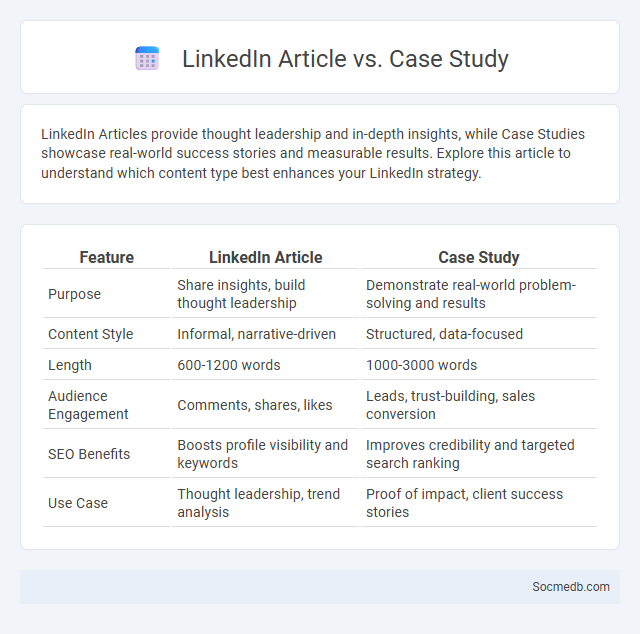
Photo illustration: LinkedIn Article vs Case Study
LinkedIn Articles provide thought leadership and in-depth insights, while Case Studies showcase real-world success stories and measurable results. Explore this article to understand which content type best enhances your LinkedIn strategy.
Table of Comparison
| Feature | LinkedIn Article | Case Study |
|---|---|---|
| Purpose | Share insights, build thought leadership | Demonstrate real-world problem-solving and results |
| Content Style | Informal, narrative-driven | Structured, data-focused |
| Length | 600-1200 words | 1000-3000 words |
| Audience Engagement | Comments, shares, likes | Leads, trust-building, sales conversion |
| SEO Benefits | Boosts profile visibility and keywords | Improves credibility and targeted search ranking |
| Use Case | Thought leadership, trend analysis | Proof of impact, client success stories |
Introduction to Content Types
Social media platforms offer diverse content types such as images, videos, stories, reels, and live streams, each designed to engage different audience preferences. Understanding these formats helps tailor Your marketing strategy to maximize reach and interaction. Choosing the right content type can boost visibility and foster meaningful connections with followers.
Defining LinkedIn Articles
LinkedIn Articles represent a powerful content format within the LinkedIn platform, designed to provide professionals with opportunities to publish extended, in-depth posts that establish thought leadership and industry expertise. These articles support rich media such as images, videos, and hyperlinks, enhancing engagement and shareability across LinkedIn's vast business network. By utilizing LinkedIn Articles, users can significantly boost their professional visibility, foster meaningful connections, and drive targeted traffic to personal or corporate profiles.
What is a Case Study?
A case study is an in-depth analysis of a specific social media campaign or strategy, highlighting the goals, methods, and measurable outcomes. It provides valuable insights into what worked and what didn't, supported by data such as engagement rates, follower growth, and conversion metrics. Understanding a case study helps you apply proven tactics to improve your own social media performance.
Traditional Articles Explained
Traditional articles typically emphasize in-depth analysis, well-structured narratives, and verified information, contrasting with the brief, fast-paced content common on social media platforms. These articles provide comprehensive context, fostering critical thinking and detailed understanding of topics. Enhanced by expert opinions and extensive research, traditional articles maintain credibility and authority absent in many social media posts.
Purpose and Audience Differences
Social media platforms serve distinct purposes, ranging from professional networking on LinkedIn to casual sharing on Instagram. Your content must be tailored to the specific audience demographics and engagement preferences of each platform. Understanding these differences ensures more effective communication and maximizes your social media impact.
Structural Comparison
Social media platforms vary significantly in structural design, with Facebook utilizing a graph-based network to connect users through mutual relationships, while Twitter organizes content around real-time, chronological feeds and hashtag-driven topic clusters. Instagram's visual-first interface emphasizes image and video sharing supported by algorithmic content recommendations, contrasting with LinkedIn's professional network that structures connections based on industry, skills, and endorsements. These structural differences impact user interaction patterns, content discovery, and community formation across social media ecosystems.
Content Depth and Detail
Social media content thrives on depth and detail, engaging audiences through well-researched posts, rich multimedia, and informative storytelling that provides real value. Your content should delve beyond surface-level information, incorporating statistics, expert insights, and authentic narratives to foster trust and increase user interaction. Thoroughly detailed content not only enhances visibility in algorithms but also encourages meaningful conversations and long-term audience loyalty.
Engagement and Reach Potential
Maximizing your social media engagement boosts visibility by encouraging likes, comments, and shares that algorithmically expand your content's reach potential. Creating interactive posts tailored to your target audience increases both organic reach and meaningful interactions, fostering a loyal community. Utilizing data-driven insights to optimize posting times and content formats enhances your overall reach across platforms like Instagram, Facebook, and Twitter.
Best Use Cases for Each Format
Images excel in driving engagement on platforms like Instagram and Pinterest by capturing attention with visually compelling content. Videos perform best on Facebook, TikTok, and YouTube, where storytelling and dynamic visuals boost viewer retention and brand awareness. Text-based posts thrive on LinkedIn and Twitter, providing concise insights, news updates, and professional networking opportunities that encourage interaction.
Choosing the Right Format
Choosing the right format on social media significantly impacts your engagement and reach. Visual content like images and videos tend to perform better, capturing your audience's attention quickly and encouraging interaction. Tailoring your format to the platform and your audience's preferences helps you maximize the effectiveness of your social media strategy.
 socmedb.com
socmedb.com